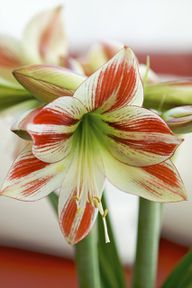When caring for amaryllis need to pay attention to a few things. Due to its life cycle, the subtropical plant has special requirements that should be met for a beautiful bloom.
Caring for a plant involves more than just giving it the right amount of water. Various factors affect the growth and health of plants. The amaryllis is no exception – below you will find the most important facts about the optimal care of the flower.
By the way, the amaryllis is also called the knight star.
Contents
Amaryllis care: The ideal location
When it comes to the right location for the amaryllis, no blanket answer can be given. The plant goes through three different phases throughout the year:
the flowering phase between December and February
the growth phase from February to August
and the dormant phase from August to December
At each of these stages, the delphinium makes different demands on its location.
During the blooming phase, it is best to find it a bright windowsill without blazing sun. The amaryllis likes it warm during this time: it should be between 18 and 22 degrees Celsius.

During the growth phase, you can either leave it in this location or move it outside to the balcony or terrace. Now it also tolerates sun.
During its dormant period, the amaryllis likes it cool and dark. Temperatures should be between five and ten degrees Celsius during this time. A cellar or dark, unheated stairwell are good places for it.
Properly fertilize and water amaryllis

In each phase you need to water and fertilize differently.
During the flowering period:
When the amaryllis bulb is replanted in new soil in November after the dormant period, moisten the soil only slightly at first.
Once the stem grows and reaches about eight to ten inches in length, you can water moderately once a week.
During the growing season:
When the flowers have wilted in February, cut them off along with the stem.
Water the plant about twice a week. Waterlogging should be avoided, but the root ball should not dry out completely.
From now on you can also use liquid fertilizer. First once every three weeks, then once every two weeks starting in May.
In the resting phase:
From August, you should stop watering and fertilizing. Let the leaves wilt and cut them off in September.
Do not water the bulb until the end of November and leave it in a cool place.

